The Google Pixel C Review
by Brandon Chester & Joshua Ho on January 25, 2016 8:00 AM ESTGPU Performance
Even to this day, Tegra K1 has held the crown for best GPU performance in a mobile Android device. From one point of view this is quite impressive, as it shows how NVIDIA was able to build a GPU that no other SoC vendor apart from Apple was able to beat. From another point of view, it's quite concerning to see that nobody apart from Apple values GPU performance enough to try and beat NVIDIA's chips.
Being an NVIDIA SoC, Tegra X1 is paired with a GPU designed in-house by NVIDIA. More specifically, it’s a 256 core part based on their Maxwell architecture. We’ve already seen how this GPU performs in the SHIELD Android TV, but due to being battery powered and having stricter thermal constraints, there will obviously be differences in performance between it and the Pixel C. In this case, it appears that the GPU is also running at a lower frequency than the SHIELD Android TV. While it has been estimated that the SHIELD Android TV's version has a peak GPU frequency of 1GHz, I believe the implementation used in the Pixel C has a peak GPU clock of approximately 850MHz. It’s also worth noting that the Pixel C uses the open source Nouveau kernel drivers that differ from NVIDIA’s kernel drivers on the SHIELD Android TV and SHIELD Tablet K1, and it doesn’t have full OpenGL support which has been the case with Google’s previous Tegra-powered devices as well. With all that in mind, lets dive into our standard mobile GPU test suite to evaluate the GPU performance of the Pixel C.
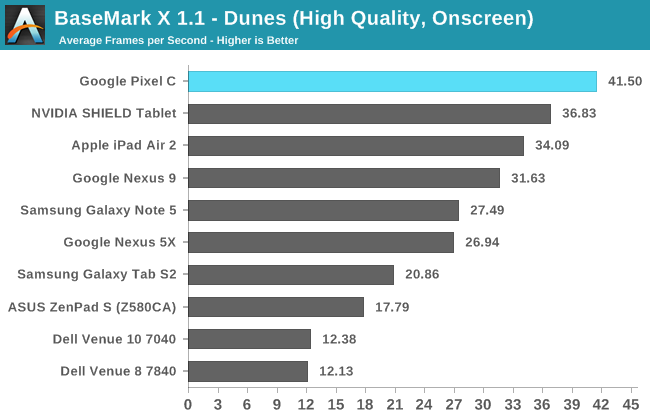
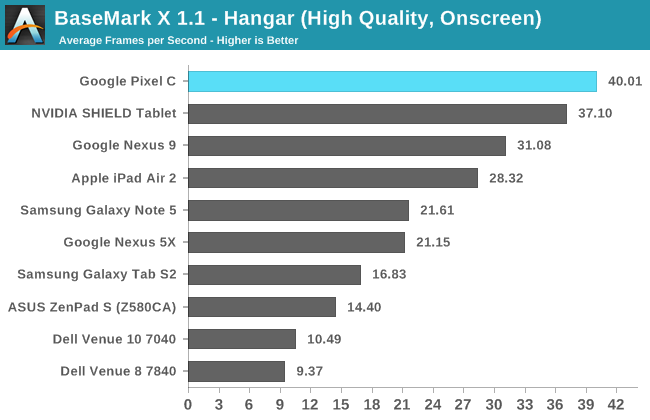
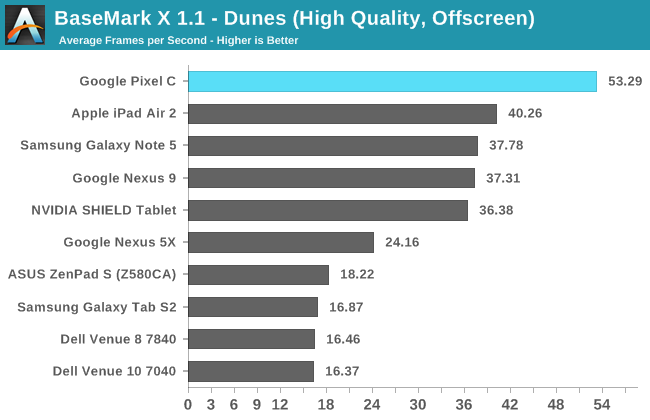

There's not a whole lot to be said about the Pixel C's performance in BaseMark X beyond saying that it's faster than any other Android device by a large margin. Even in the on screen tests, the Pixel C with its substantial resolution is still the fastest device on the charts. Absolute GPU performance as shown in the off screen tests shows a 43% performance improvement over the Tegra K1 used in the Nexus 9.
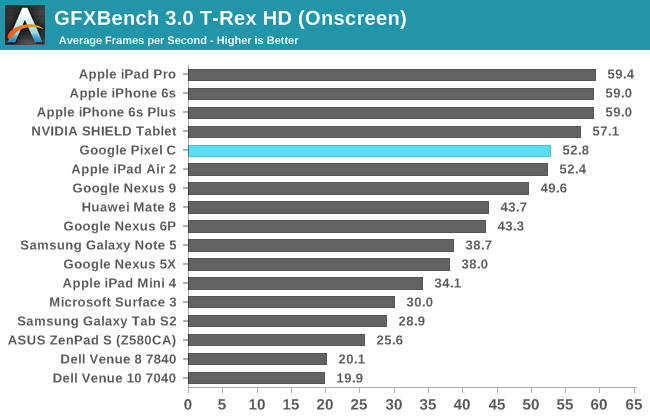
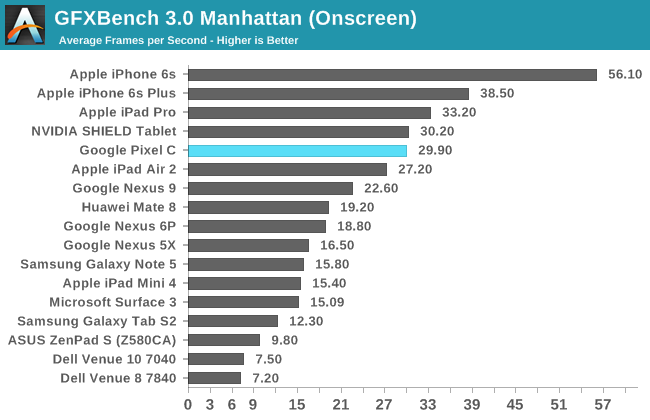
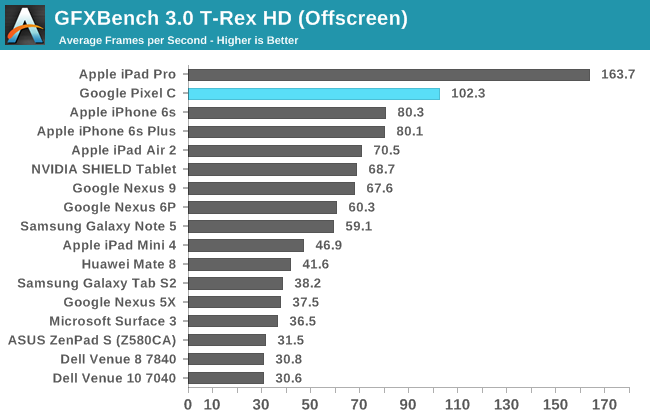
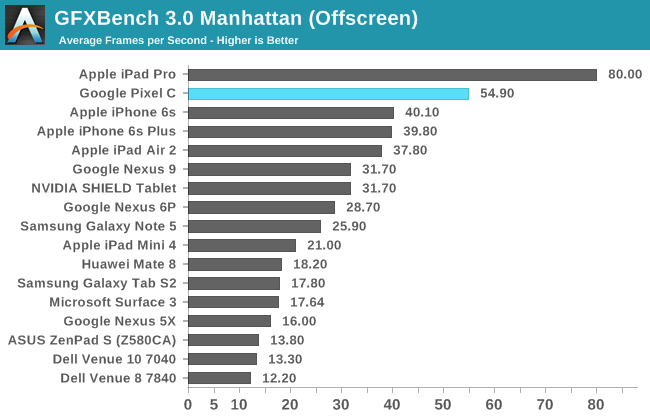
In GFXBench's T-Rex on screen test the Pixel C comes very close to hitting the Vsync limit despite its relatively high resolution. Off screen performance in both T-Rex and Manhattan is exceptional, and both tests make it clear that the Pixel C has the most powerful GPU in any mobile Android device. The gap between it and the next fastest device is quite large too, and the only tablet that can beat it is the iPad Pro with its A9X SoC.
The GPU performance of the Pixel C is unparalleled in the Android space. Not only that, but it ends up being faster than any similarly sized tablet, including the iPad Air 2 and of course the Nexus 9. It’s certainly impressive, and while I don’t mean to take away from the achievement, I can’t help but wishing that we had seen Tegra X1 come to market a bit sooner. Beating out A8X and Tegra K1 is great, but the former of those SoCs is also now well over one year old. While comparing to the iPad Pro is unfair in some respects due to the size difference, both devices do sell themselves as tablets priced for productivity, both launched at around the same, and NVIDIA’s GPU isn't as fast as the one in A9X. That being said, at $799 the iPad Pro is also significantly more expensive than the Pixel C, and relative to its price the Pixel C offers amazing GPU performance. The only concern would be if A9X shows up in some sort of regular sized iPad priced at the same level as the Pixel C. While I certainly do wish we could have seen Tegra X1 in some sort of tablet a bit earlier in the year, right now it does stand as the chip with the fastest GPU to ship in a standard size tablet, and I don’t think it will disappoint even when playing the most intensive 3D games.
Storage Performance
Something that hasn't been investigated very thoroughly in the past is smartphone storage performance. However, among high end devices this is now becoming a point of differentiation. Apple has moved to their own storage solutions that use NVMe and run over PCIe, while Samsung is pushing forward with UFS 2.0. While the Pixel C is a premium tablet, it ships with a standard eMMC storage solution. It also has Google's disk encryption enabled, which has been shown to impact storage performance in the past.
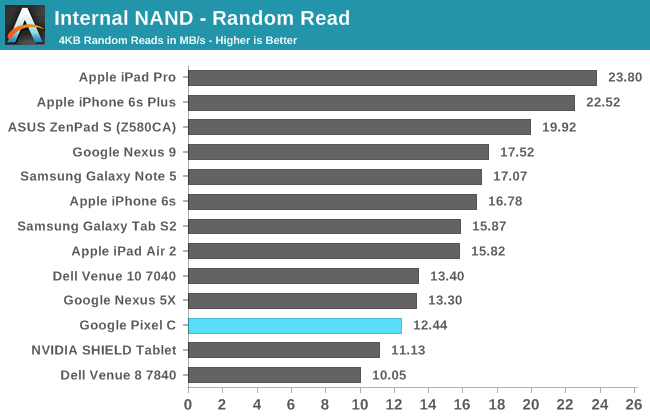

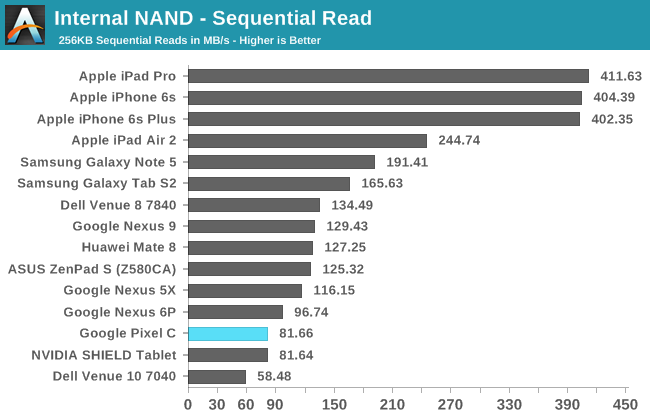
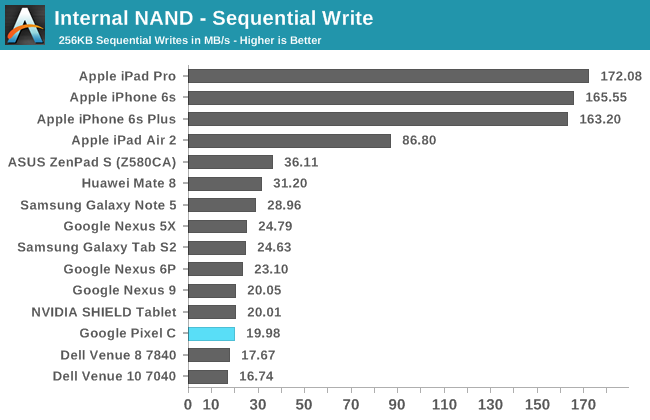
Like every Android device that Google has been involved in developing, the Pixel C doesn't fare well with our storage performance tests. Random reads and writes decent, although not competitive with new storage solutions like the SSD in the iPhone 6s and iPad Pro. Sequential speeds are simply not good at all, and definitely not competitive with what you'll get in an Apple device from the past two years or anything with an unencumbered and halfway decent eMMC or UFS storage solution. There's not much point in going over this issue again, because at this point it's clear that Google doesn't consider storage performance to be a metric worth competing on. I think it is, and I think that users end up appreciating the benefits of faster storage through quicker app installations, less loading when working with large files, among other benefits, even if they don't know what's driving those improvements behind the scenes. It's definitely something to think about when considering the Pixel C as a tablet, especially if you have a productivity focus.










122 Comments
View All Comments
valentin-835 - Monday, January 25, 2016 - link
The tablet has issues. You kind of get what you pay for. I mean, it's half the price of an IPad Pro. And less than half that of a Surface.The biggest drawback however is the lack of an advanced graphics API like Metal or DX12. Without that, they are dead in the water. I heard Google is pushing hard to get Vulkan released. Both drivers and specification should be out soon.
styleruk - Monday, January 25, 2016 - link
Hmm, there seems to be an awful lot of points about a Google tablet or android tablet not being much more than a big phone. I have to disagree. I use the N9 for business and pleasure. I often type out reports on the N9 at airports, watch movies, read mags, books and play occasional games. I've had both android and apple phones both have good and bad points, currently on apple phone, but at work there are 2 iPad tablets I could use if I wanted, but they are simply too restricted to my needs. For me, the N5 + Google's more open approach is far more efficient. Up to now, I've had no problem with lack of multi task... to fill in my diary and read an email is simply to switch...its no biggie. If I want more I wait until I'm in front of a PC at work or home.I also like the way everything Google works together well.
Regarding this device, I'm on the cusp of upgrading my N9, but quite why I can't see yet. Until I actually pick it up and try it, I'm not ordering it, as the last upgrade was from the N7(2013), to N9, and whilst bigger, it's not really faster. On paper, the pixel C is not much faster than the N9!
The jury is still out...but stop saying that android tablets are just big phones, I have the choice and I don't agree at all.
tuxRoller - Monday, January 25, 2016 - link
Just looking at the benchmarks, your not judging this device fairly.The nexus 9 had a processor that was basically designed for benchmarking and nothing else. It just falls on its face when the code becomes branchy. Iow, benchmarks were an unusually poor indicator of typical performance.
That aside, the pixel is performs pretty much exactly where you'd expect it to perform given its CPU: between the nexus 5x and the 6p FOR MOST TESTS.
Iow, no surprises.
I'd also like to point out that the weight is only an issue if you have some physical issues, or are just used to very light tablets. I received the pixel c for Xmas and have had no issues transitioning to it from the 2013 nexus 7. My gf even noted when she first picked it up that "this isn't very heavy" (she'd read the reviews which complained about its weight).
I certainly have issues with it (it often doesn't respond to touches, sometimes the interface becomes so slow I have to force a restart) but it's still an awfully good TABLET for the price.
c4v3man - Monday, January 25, 2016 - link
I gave up on waiting for a return to sanely priced android tablets and went with a Dell Venue 11 Pro 7140. Like most non-apple products they don't hold their value particularly well, so I was able to score a Core 5M71 256GB SSD version with the keyboard for under $600. While heavier than initially anticipated, I get excellent battery life (13+ hours real world display use with the keyboard battery), and an extremely snappy tablet that even handles light Adobe Lightroom usage. That and it works on a lap, unlike a Surface, and is serviceable (good luck replacing the battery/ssd in your surface). Remix OS works on it as well if I need to get my android fix, and will likely get better with more development. I guess I don't see the point of using a more limited OS on a $500+ device... If you're going for productivity and charging a premium, give me a full experience. If it's a limited experience, it better come with a "limited" price.Jerch - Monday, January 25, 2016 - link
Always sad to see the Nexus 7 (2013) omitted from display lists, since even though it is now firmly outdated, it had a great screen that would still be at the top of some of these tests -- notably max brightness. It's the perfect beach tablet. Cheap, durable, and BRIGHT.EludiumQ36 - Monday, January 25, 2016 - link
I have a 32GB Pixel C and take it from a regular user as opposed to a professional reviewer/critic - it's a very good tablet. I use it as a true tablet sans keyboard which mitigates much of the complaining. It features a beautiful and very responsive display (utilizing Android 6.0.1). It was my perfect choice because (1) the Nexus 10 is no longer available, (2) it's far less expensive than the 10-in Samsung tablets (which are stuck on KitKat), and (3) it's basically a Nexus with first-in-line upgrades. Having said that, there is a highly reported problem of Wifi performance degradation - I experience a 60% hit but still get 26Mbps to it, so... - but they'll issue a fix for that soon enough. I highly recommend it if you count yourself as a "regular" user.R. Hunt - Tuesday, January 26, 2016 - link
Granted, Samsung is not great with updates. That out of the way, even last year's Tab S is been on Lollipop for months. And how is this less expensive than say, the Tab S2?Jumangi - Monday, January 25, 2016 - link
Google just doesn't care about making Android a good experience on larger tablets. Until,they do we will get half baked products like this and the iPad will continue to be the standard.McChen - Tuesday, January 26, 2016 - link
One thing that wasn't mentioned in the review is that the Pixel C supports faster charging (12V @ 2A, 24W) via USB PD using a charger such as the Pixel laptop charger. I have one and indeed the tablet charges very fast with it. I believe one of the Google engineers said it charges 0 to 100 in about 2.5 hours, compared to just over 4 hours in this review with the standard 15W charger. Would be interesting to see a charging time test with a USB PD charger.Jumangi - Tuesday, January 26, 2016 - link
They used the charger the device comes with as they should.